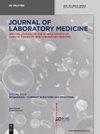Development of a peripheral blood morphology proficiency assessment program using the CellaVision® Proficiency Software
IF 1.1
4区 医学
Q4 MEDICAL LABORATORY TECHNOLOGY
引用次数: 0
Abstract
Abstract Objectives Proficiency programs allow hospital laboratories to evaluate and improve diagnostic performance. A cloud-based proficiency program was launched in 2017 to standardize peripheral blood morphology assessments in hospital laboratories across the province of Nova Scotia. Methods The CellaVision® Proficiency Software was used to evaluate peripheral blood morphology assessments. A different blood film featuring a specific red or white cell finding or normal morphology was evaluated each month. Each hospital’s proficiency slide completion and pass rates were monitored, which helped inform remediation efforts. Results In 2017, 213 medical laboratory technologists from 14 hospital laboratories enrolled in the proficiency program. The average completion rate for monthly proficiency assessments between 2017 and 2022 was 90 %. During that time, the pass rate increased from 59 to 95 % and 73 to 89 % for red and white blood cell assessments, respectively. By 2022, four hospital laboratories and 83 medical laboratory technologists stopped performing peripheral blood assessments. Conclusions The CellaVision® Proficiency Software facilitated a centralized peripheral blood morphology proficiency assessment program for geographically distributed hospital sites. The use of this software increased the quality of peripheral blood morphology assessments in Nova Scotia by simplifying the evaluation of and education on peripheral blood morphology skills.使用 CellaVision® 能力评估软件开发外周血形态学能力评估程序
摘要 目的 通过能力验证计划,医院实验室可以评估和提高诊断绩效。新斯科舍省于 2017 年启动了一项基于云的能力验证计划,以规范全省医院实验室的外周血形态学评估。方法 使用 CellaVision® 能力评估软件来评估外周血形态学评估。每月评估一张不同的血片,其特征是特定的红细胞或白细胞发现或正常形态。对每家医院的能力切片完成率和通过率进行监测,这有助于为补救工作提供信息。结果 2017 年,来自 14 家医院实验室的 213 名医学检验技师参加了能力验证计划。2017 年至 2022 年期间,每月能力评估的平均完成率为 90%。在此期间,红细胞和白细胞评估的通过率分别从 59% 上升到 95%,从 73% 上升到 89%。到 2022 年,4 家医院实验室和 83 名医学实验室技师停止了外周血评估。结论 CellaVision® 能力评估软件促进了针对地理位置分散的医院场所的集中式外周血形态学能力评估计划。该软件的使用简化了外周血形态学技能的评估和教育,从而提高了新斯科舍省外周血形态学评估的质量。
本文章由计算机程序翻译,如有差异,请以英文原文为准。
求助全文
约1分钟内获得全文
求助全文
来源期刊

Journal of Laboratory Medicine
Mathematics-Discrete Mathematics and Combinatorics
CiteScore
2.50
自引率
0.00%
发文量
39
审稿时长
10 weeks
期刊介绍:
The Journal of Laboratory Medicine (JLM) is a bi-monthly published journal that reports on the latest developments in laboratory medicine. Particular focus is placed on the diagnostic aspects of the clinical laboratory, although technical, regulatory, and educational topics are equally covered. The Journal specializes in the publication of high-standard, competent and timely review articles on clinical, methodological and pathogenic aspects of modern laboratory diagnostics. These reviews are critically reviewed by expert reviewers and JLM’s Associate Editors who are specialists in the various subdisciplines of laboratory medicine. In addition, JLM publishes original research articles, case reports, point/counterpoint articles and letters to the editor, all of which are peer reviewed by at least two experts in the field.
 求助内容:
求助内容: 应助结果提醒方式:
应助结果提醒方式:


